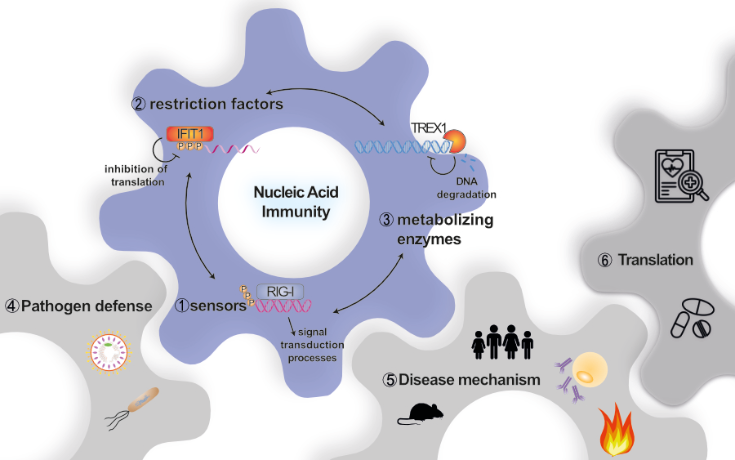Overview
Until the establishment of this CRC, the different mechanisms of nucleic acid defense in vertebrates have generally been studied separately and unrelated to each other. This initiative integrates them under the same umbrella: Nucleic Acid Immunity is the holistic approach to study the interaction of (1) nucleic acid recognizing pattern recognition receptors ("sensors"), (2) restriction factors and (3) nucleic acid-metabolizing enzymes in the context of foreign nucleic acid recognition. Given the close interrelationship of these systems, an integrated approach, such as the one pursued in this consortium, is warranted to study them.
While this system is evolutionarily adapted to recognize microbial and viral pathogens, its erroneous activation is the cause of many sterile inflammatory diseases characterized by abnormal activation of an antiviral state. Studying these diseases and their underlying pathways will not only provide new insights into disease pathology, but will also allow us to develop tools for more sensitive and specific disease diagnosis and prognosis. At the same time, we expect that our findings will enable us to develop new therapeutic strategies in the long term.

Figure: Nucleic Acid Immunity. Shown are the main research topics of the CRC Nucleic Acid Immunity. The initiative focuses on the integrative exploration of how nucleic acid sensors, restriction factors, and metabolising enzymes work together to enable reliable nonself-recognition on the one hand and to avoid erroneous self-recognition on the other. While the physiological role of Nucleic Acid Immunity is to defend against pathogens, from the cell-autonomous to the organismal level, its misdirected activation can lead to a range of sterile inflammatory diseases characterised by a distinctive type I IFN signature. In addition to elucidating these mechanisms at the molecular level, the goal of this initiative is to use the results to improve diagnosis, prognosis, and therapy in patients.

